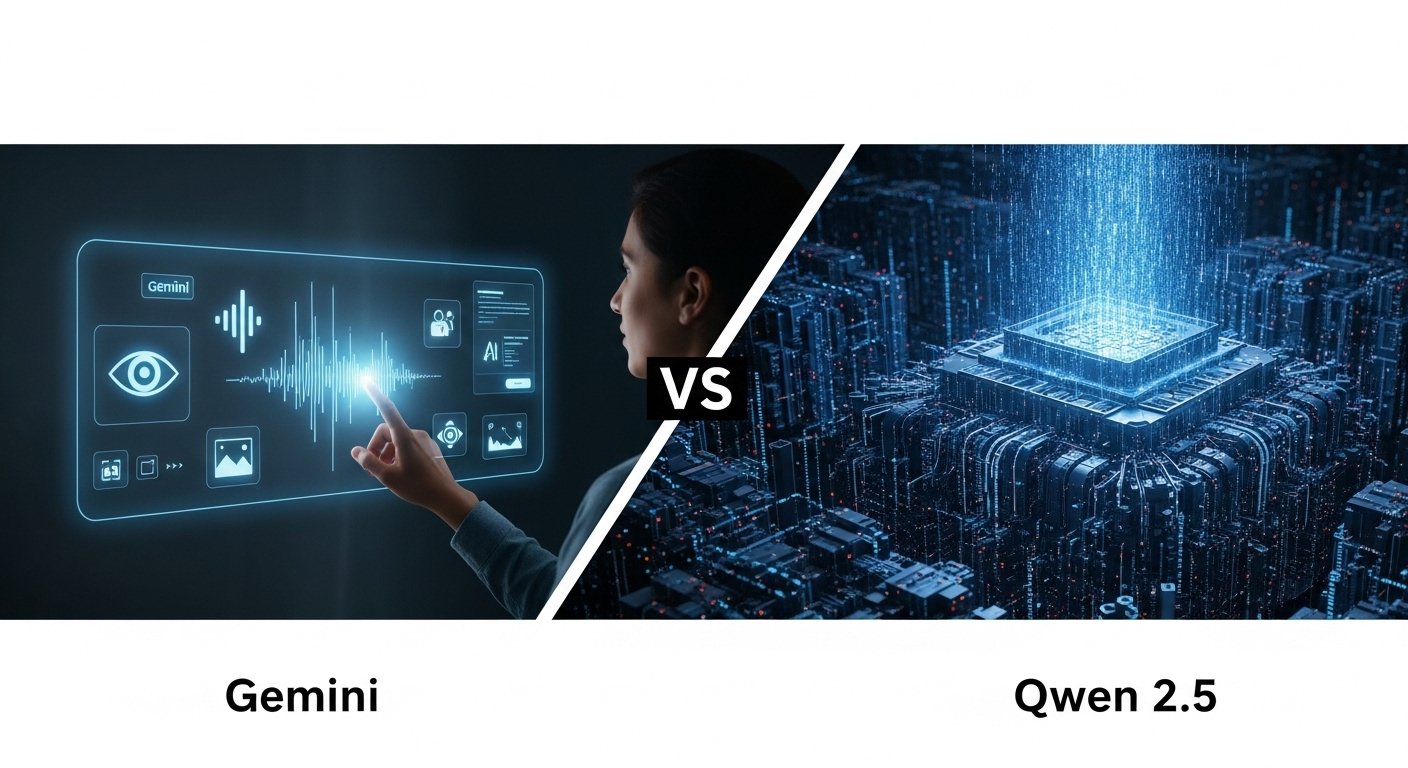The AI industry landscape has seen a significant change from a single region or company to a more global and diversified one. A new global situation has been established, where the east forces are the ones who challenge the dominant established players of the west by showing their strength as greatness and having the goal to be the most powerful. The competition between Gemini and Qwen 2.5 is the most exciting in the major league of AI. It is not only a technical comparison, but also a comprehensive one by the execution of the strategies of the two giants, who respectively represent Google’s vision of an integrated, multimodal future and Alibaba’s aggressive, multifaceted play for market dominance.
The recent release of the Gemini 2.5 Pro from Google being the foremost and the most advanced in-house AI player indicates Google’s vision of developing the core of an intelligent ecosystem through a product that is deeply integrated. On the contrary, Alibaba Cloud’s Qwen 2.5 is launching, not only a single, but a series of strong models, which are the basis of its performance, they avidly speak of their own proprietary technologies, and they wear the mask of community spirit.’ The dichotomy signifies a profound and identifiable pattern of the AI design and strategy territory: a reserved universe of multi-modality versus an unlimited cloud city that is mainly characterized by text processing on an extraordinary scale.
Insights into the conjunction of Gemini vs. Qwen 2.5 are invaluable for developers, enterprises, and tech enthusiasts for it helps them perceive the small differences between the two. This in-depth analysis will get to the bottom of their core philosophies, architectural innovations, benchmark performance, and killer features to bring out the most appropriate AI giant for specific tasks.
1. The Philosophical Battleground: Integration vs. Domination
The DNA of Google and Alibaba Cloud sets the stage for their AI children. One of them is poised to organically strengthen the existing ecosystem, while the other is determined to monopolize new areas on all fronts.
1.1 Google’s Gemini: The Integrated Multimodal Vision
The basic idea of Google’s mission for organizing the world’s information is closely related to the Gemini conception. It is not the end product, but an intelligent layer whose target is to make all Google services the most helpful and intuitive that the users can think of.
- Core Philosophy: One AI model that does everything natively, which means understanding text, pictures, music, and video, etc. This is in line with a user experience that is hitchless, dialoguing, and situational.
- Strategic Focus: Gemini’s ascent stands on Google’s ecosystem improvement. Better Search, Workspace features, intelligent Android, and future hardware are its measures of success. In all, it is a kind of “walled garden” wherein emphasis is given on providing the finalized, safe, and highly integrated products.
1.2 Alibaba’s Qwen 2.5: The Hybrid Powerhouse
Qwen (Tongyi Qianwen) is Alibaba’s strategic weapon in the global AI market battle. The basic idea of the design is that the attack will not only be forceful, but it will also depend on the user’s performance, added features, and, most importantly, accessibility.
- Core Philosophy: The creation of reference paths to the top and challenging the top models sold by market leaders are the two essential dimensions of the concept. The idea is to output top-notch proprietary products (e.g., Qwen 2.5 Max) challenging the industry’s best and creating open-source platforms that are accessible for the community to work with.
- Strategic Focus: The aim is to capture the market and turn the product into a commodity. The use of high-speareshow om of open-source models will allow the developers to compete without worrying about corporate profit. It does not only offer the big organizations uncommon features at a fair price like the dense context window but also it is looking to be the top choice for large-scale AI computing processing.
2. Architectural Showdown: Multimodality vs. Massive Context
The technical foundations of Gemini and Qwen of which the descriptions are the most essential reveal their unique strengths coming from significant differences in design intent.
2.1 Gemini 2.5 Pro: Natively Multimodal by Design
The main novelty that the Gemini architecture brings is that it is a single one. It’s not just an “easy” job for the model to process both images and sound or only texts, it’s “a thinking” of two modalities at the same time.
- Unified Reasoning: Unlike models that use separate components to process different data types, Gemini’s single neural network is trained on interleaved multimodal data. It thus can carry out intricate cross-modal reasoning, like looking through a silent video of a person talking and scribbling roughly what he/she is probably saying, or annotating a complex physics diagram and explaining the concepts openly. It is this type of architecture that mill the machines enabling them to converse in real-time with utmost ease, both video and voice.
2.2 Qwen 2.5: Master of Scale and Efficiency
Qwen is designed to solve two problems: the huge amount of information it can handle and the energy it can consume while doing it.
- Mixture-of-Experts (MoE): The biggest Qwen models have an MoE architecture. Instead of engaging a monolithic model for every task, a smart “router” directs each query to a small group of specialized “expert” networks. This dramatically reduces computational cost and increases speed, allowing Qwen to deliver elite performance more economically.
- The 1 Million Token Context Window: This is Qwen’s signature feature and a true game-changer. While the Gemini Pro has a large 1 million token context window, there are also some open-source Qwen models coming with this specification. This feature allows the model to absorb and have the equivalent of an entire novel, a huge legal file, or a complete enterprise codebase in mind, resulting in a prompt only, which still has all the memory and context required. This is a capability that efficiently unlocks use cases which previously had no representation as far as the publicly available models are concerned.
- General Reasoning and Knowledge (MMLU, etc.): The leading AI reasoning solutions, Gemini 2.5 Pro and Qwen 2.5 Max, are in direct competition at the very top of the card. Gemini usually becomes #1 in more sophisticated and creative problem-solving tasks in English.
- Coding (HumanEval, etc.): There is a tough war on this front. Code generation with Gemini 2.5 Pro is a highly productive job. In contrast, the CodeQwen models which were developed based on the knowledge of the whole world’s code are highly efficient in generating and debugging complex codes, thus outperforming the former, mostly when they are within a wide context window such as a large project.
- Multimodal Tasks (MMMU, etc.): Only the Gemini model is the winner. It is by nature a multimodal model, which definitely gives it a head start in the era where the understanding and inference of multiple entries has been challenging, and it has that capability both in video, audio, and text. Qwen-VL by Qwen is an exemplary vision model but it still remains that this model is not as deeply integrated as Gemini’s all-in-one design.
4. Head-to-Head Comparison Table
| Feature | Google Gemini 2.5 Pro | Alibaba Qwen 2.5 |
|---|---|---|
| Core Philosophy | Proprietary, ecosystem-integrated | Hybrid (proprietary & open-source), market capture |
| Key Strength | Native multimodality, seamless user experience | Extreme context window, open-source models, cost-efficiency |
| Architecture | Unified multimodal transformer | Mixture-of-Experts (MoE) for efficiency |
| Context Window | Up to 1,000,000 tokens | Up to 1,000,000 tokens |
| Multimodal | Leader: Natively integrated text, image, audio, video | Strong: Capable vision models, but less integrated |
| Open Source? | No | Yes: Offers a family of powerful open-source models |
| Target Audience | General users, enterprises in the Google ecosystem | Developers, enterprises needing scale, researchers |
| Killer Feature | Real-time, fluid voice and video conversation | Analyzing massive documents (1M tokens) in one go |
Conclusion: Choosing Your AI Champion
The Gemini vs. Qwen 2.5 debate doesn’t have a single winner, but it does have clear use cases where one model definitively outshines the other. Your choice depends entirely on your priorities.
Choose Google Gemini 2.5 Pro if:
- The most important thing you need is an AI that is real and can act concurrently with you. You can visit the available shops and talk in to the product the same way you would have done in a real conversation.
- You are a person who is heavily dependent on Google and at the same time, you need an AI that can access Search, Workspace, and Android without interruption.
- User satisfaction and ease of use are at the top of your list and you are okay with not having the very highest level of control or not managing really big data sizes.
Choose Alibaba Qwen 2.5 if:
- One of your major responsibilities is reading, understanding, and processing very extensive documents. Your primary tasks may include analyzing legal cases, financial reports, or even entire codebases.
- If you are a developer or an enterprise, privacy, flexibility, and cost control are the key words for you. You need a model that is powerful and open-source so that you can adjust and host it yourself.
- The point of API user is the scalability of costs at which API usage can be made while still keeping the cost per transaction down.
- If you are a businessman doing business either in China or any other Asian country where the Chinese language is native or dominant, the unique language capabilities of Qwen will be an advantage for you.
In the long run, Gemini gives a peek into the future of human-computer interaction, but Qwen already provides the necessary strength and open channels to develop industrial-scale AI applications.

